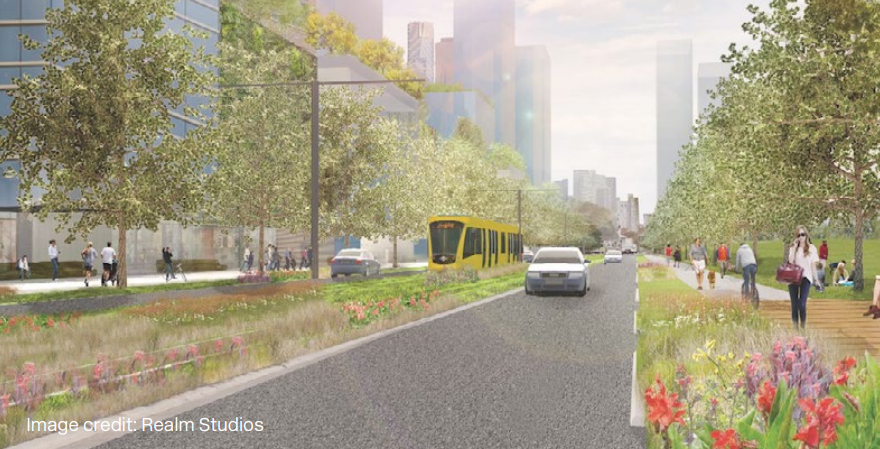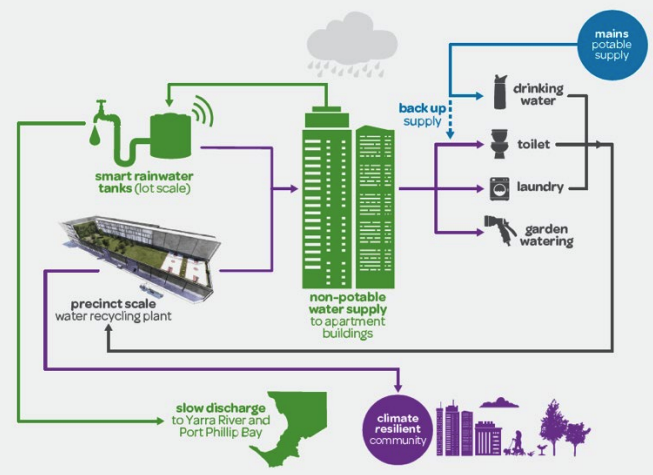Collaboration results in water management innovations for Fishermans Bend
Integrated water management depends on quality partnerships. Partnerships support collaboration, align cultures, and build consensus. Multi-stakeholder forums can bring people together to build these enduring partnerships.
A great example of a productive collaborative forum that achieved innovative, integrated water management solutions is at Fishermans Bend, in inner Melbourne. At the request of its partners, the CRCWSC worked with the Department of Environment, Land, Water and Planning, Melbourne Water, South East Water, the City of Port Phillip and the City of Melbourne to plan Fishermans Bend. Beginning in 2014, this collaboration continues today, with the Drainage Working Group still reporting to the Fishermans Bend Taskforce Board.

The project
Fishermans Bend is a 485 ha urban renewal project in inner Melbourne. Over the next 40 years, it will replace existing industrial uses with a mix of mid and high rise development, as well as an advanced manufacturing and engineering precinct. Eventually, it will be home for over 80,000 people, with another 80,000 people visiting daily for work. This scale and profile presented a unique opportunity in building water sensitive cities since the economies of scale help to support novel infrastructure approaches and ‘best in class’ approaches to water servicing and urban development.
From a water management perspective, the project has four key drivers:
- Green Star rating—The vision for Fishermans Bend is to become Australia’s largest Green Star Community
- Sustainability goals in the Fishermans Bend Framework guide water management goals:
- No hotter than inner Melbourne
- Reduced nutrient discharges
- Sewerage discharges reduced by 50%
- Less than 100 litres of potable water used per person/day
- Reduced storm and flood impacts, including sea levels
- Constrained site—Development needs to respond to significant environmental constraints including high water table, high levels of ground contamination, tidal and storm surge issues, and projected sea level rise issues
- Exemplary urban design outcomes—There’s a desire to incorporate water in the landscape, and to facilitate an approach to finished floor levels in buildings that could support exemplary urban design outcomes.
Our contribution
For the CRCWSC, Fishermans Bend presented an opportunity to form an ongoing partnership with a major project and its stakeholders. We were invited to play an active role at several key stages, to help shape the response to key drivers.
Central to our involvement was a research synthesis workshop in 2014 that set the scene for water innovation in subsequent years. The co-design process we hosted brought together researchers, government, and industry stakeholders in three workshops to discuss emerging research and international best practice. This process developed a number of ‘Ideas for Fishermans Bend’ , and also fostered ongoing collaboration and innovation which has been a hallmark of water planning for Fishermans Bend. This innovation ha since been expressed at various scales across the site:

- Whole of Fishermans Bend scale
- Governance model—A multi-stakeholder Steering Committee was established, and later a Drainage Working Group reporting to the Fishermans Bend Taskforce Board. This group of senior executives of key partner organisations prepared a water sensitive city strategy that informed infrastructure strategy, precinct planning and water related developer contributions for Fishermans Bend.
- Research + industry—Continuing partnerships with research organisations (e.g. CRCWSC) and expert consultants (e.g. GHD) provide technical and innovation support. Importantly, these experts worked closely together and were embedded with stakeholder planning teams during critical phases.
- Precinct scale
- Integrated water management strategy—A strategy of ‘making water locally’ centres around a water recycling plant to provide Class A recycled water. Importantly, this plan could seed wider third pipe networks across the Melbourne CBD in the future.
- Flood resilience—A ‘multiple-lines-of-defence’ flood management strategy includes WSUD, planning and building controls, social resilience, upgraded pipes and pumps capacities, and a levee along the Yarra River. Flood resilience is achieved when these elements work in unison, rather than requiring each to provide flood protection in isolation.
- Urban ecology strategy—This strategy focuses on ecological values and ecosystem services in green corridors, public open space design and building design, to green, cool and naturalise Fishermans Bend.
- Street scale
- Hybrid drainage infrastructure—A hybrid drainage infrastructure approach uses linear green swales and parks, and combines with existing underground drains, to temporarily store and convey flood water. The hybrid principle extends to the function of the levee and pumps to ensure that the green swales are placed in areas where levee over-topping is more probable and water stored in green swales is efficiently drained to the Yarra River.
- Lot scale
- Smart rainwater tanks—Smart rainwater tanks allow for roofwater harvesting, while active discharge control ensures tanks are empty before an upcoming rain event.
- Flood resilient design—Flood resilient buildings located in flood prone areas employ design and materials that are more tolerant of lower level flooding and are an alternative to raising floor levels. This approach allows for better building activation and better streetscapes.
- Third pipe plumbing—All buildings will use alternative water sources (a mix of rainwater and recycled water) for washing machines, toilets, and irrigation.
The lessons
As an exercise in collaboration and integration, Fishermans Bend highlights four elements that help the process of planning for water sensitive cities in complex situations:
- having a neutral broker who can facilitate innovation and collaboration
- using iterative feedback loops between researchers, consultants and industry to create, test and refine ideas
- engaging with broad stakeholder groups at key stages through the process
- considering water services and urban form together as the same problem and as linked options.
The scale of Fishermans Bend has enabled testing of some novel approaches, including the decentralised infrastructure and governance approaches that have wider applicability in other cities and precincts. Two innovations hold promise in other urban renewals:
- Hybrid drainage was a cost-effective alternative to conventional drainage upgrades.
- An urban ecology strategy could expand the remit of urban water management. The processes used for planning Fishermans Bend are also transferable to situations that require innovation and those with a complex water cycle.
For more information about Fishermans Bend, see our newly published case study, Collaborative planning for the Fishermans Bend Urban Redevelopment.
Need help with your project?
If you are a CRCWSC participant and have an idea for a research synthesis activity, contact your relevant CRCWSC regional manager. If you are not a CRCWSC participant but interested in working with the CRCWSC on your own exciting project, contact admin@crcwsc.org.au and we will contact you to discuss your ideas.
Watch our short explainer video on research synthesis: